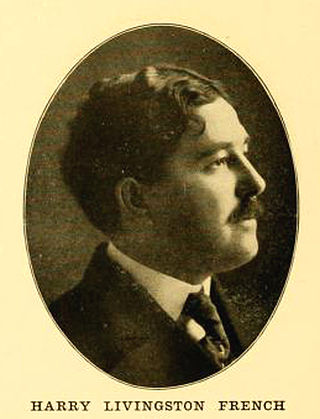
Tarleton Hoffman Bean was an American ichthyologist.
The New York State League was a minor league baseball league that played between 1885 and 1917. The league began play as an Independent level league before playing from 1902 to 1917 as a Class B level league. League franchises were based in New York and Pennsylvania. John H. Farrell served as president of the league from 1897 to 1917.

Ira Wells Wood was an American Republican Party politician who represented New Jersey's 4th congressional district from 1904 to 1913.
A.T. Still University (ATSU) is a private medical school based in Kirksville, Missouri, with a second campus in Arizona and third campus in Santa Maria, California. It was founded in 1892 by Andrew Taylor Still and was the world's first osteopathic medical school. It is accredited by the Higher Learning Commission. ATSU includes three campuses on 200 acres with seven schools and colleges.
Alfred E. Bull was an American football player, coach, rower, and dentist. He played football at the University of Pennsylvania and was selected as a center to the 1895 College Football All-America Team. Bull later served as the head football coach at the University of Iowa (1896), Franklin & Marshall College (1896–1897), Georgetown University (1900), Lafayette College (1903–1907), and Muhlenberg College (1908–1910), compiling a career college football coaching record of 62–34–15.

The Matheson was a luxury American automobile manufactured from 1903 to 1912, first in Grand Rapids, Michigan, then Holyoke, Massachusetts and from 1906 in a purpose-built factory in Forty Fort, Wilkes-Barre, Pennsylvania.

Michael Stephen Roach was a professional baseball player who caught for the Washington Senators in 1899.
The Wilkes-Barre Barons were a minor league baseball team that existed off-and-on from 1886 to 1955. They began as an unnamed team in the Pennsylvania State Association in 1886.

Harry Livingston French was an American architect based in Wilkes-Barre, Pennsylvania. He designed in a variety of styles, including classical architecture and Gothic revival. His built works included numerous banks, schools, and armories.
Dr. Jane Wells Craven was an American doctor, prize winning tennis player, World War I. ambulance driver and medic.

Owen McGlynn was an architect who practiced in Wilkes-Barre, Pennsylvania, at the end of the nineteenth century and at the beginning of the twentieth. He designed in a variety of styles, including the classical and Gothic revival. His built works included numerous banks, schools and churches.

Frank Hudson was a football player and coach who was a member of the Laguna Pueblo tribe from New Mexico.
The Johnstown Johnnies were a minor league baseball team in Johnstown, Pennsylvania that existed in various leagues between 1883 and 2002.

Charles Alling Gifford was an American architect and a partner in the New York City firm of Gifford & Bates. He is best remembered for his resort hotels, but also designed houses, churches, and five armories for the New Jersey National Guard.

William "Matty" Matthews was an American boxer of the early 20th century born and raised in New York City. He was the world welterweight champion twice between 1900 and 1901, and was one of the first boxing world champions to regain his crown. Johnny Dunn, also known as a sports announcer, was his primary manager, particularly during his reign as world welterweight champion.

Eddie Connolly was a Canadian-born boxer who took the World Welterweight Championship in a twenty-five round points decision on June 5, 1900, against reigning champion Matty Matthews at the Seaside Athletic Club in Brooklyn, New York. Earlier in his career, he took both the Canadian Featherweight Title, and the British Empire World Lightweight Title. He was exceptional to have fought for titles in three weight divisions, and to have fought in both lightweight and welterweight divisions for World Championships. His primary and best known manager was Billy Roche, who also managed champion "Mysterious" Billy Smith. He was also managed by Abe Pollack and by Eddie Kelly during his fights in England.

William V. Thompson was an American professional and champion tenpin bowler. He was the proprietor of Plaza Bowling Alley in the Chicago Plaza Hotel, the first official regulation ten-pin bowling alley. He formed a bowling club from champion bowlers and challenged other organizations across the nation. Thompson was influential in forming of the ultimate sanctioned regulations rules of the game and an advocate of the original American Bowling Congress. He was general manager of the department at Brunswick-Balke-Collender Company that made the bowling equipment for the alleys.

Nora Dunblane was an American actress and short story writer.














